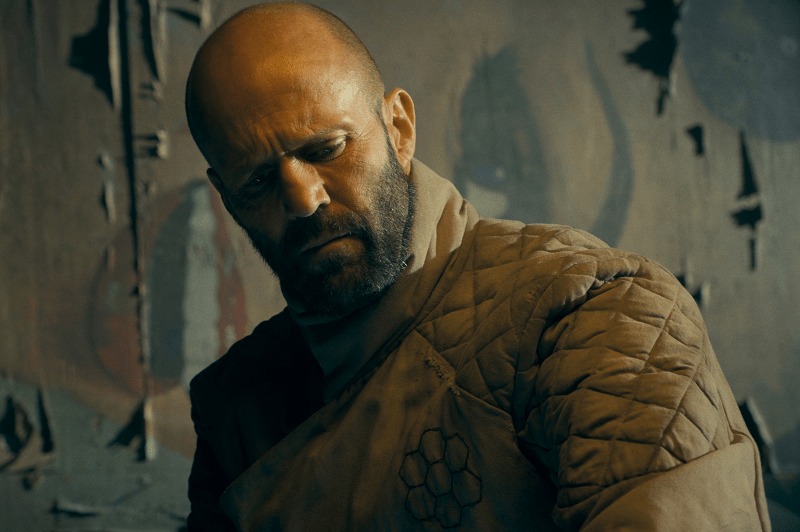When one thinks of the filmography of actor Jason Statham, films typically feature him in one of two roles: quiet badass or loudmouth badass. He’s certainly done more with turns in Snatch (2000) and London (2005) demonstrating his versatility, but it’s when he plays an ass-kicker that audiences show up and consume popcorn in mass quantities as he destroys whole forces of opponents with grace, wit, and relative ease. Statham’s latest comes in the form of mystery action The Beekeeper, directed by David Ayer (Suicide Squad; Fury) and written by Kurt Wimmer (Equilibrium; Salt), wherein the actor portrays a retired quiet badass, formerly part of a clandestine group known as “Beekeepers,” who seeks to right a terrible wrong that’s part of a larger systemic issue left unchecked. Originally released by MGM Studios, The Beekeeper comes to rest on shelves via Warner Bros. Pictures Home Entertainment, unfortunately bringing with it not a single bonus feature to explore the mythos created in this adventure.
Adam Clay (Statham) lives a quiet life, renting space on Eloise Parker’s (Phylicia Rashād) property to cultivate his bees. When Eloise is taken by digital scammers, Clay steps in to make them pay. But the data mining farm that abused Eloise is merely one piece in a larger behemoth that Eloise’s daughter, FBI Agent Verona Parker (Emmy Raver-Lampman), has already been trying to infiltrate. As Clay decimates one portion of the operation after another, a question begins to form about this singular man and his strange ability to cause decisive havoc wherever he goes — the answer creating fear throughout the hallowed halls of justice and the elaborate systems that run throughout the country.

Seeing as The Beekeeper had its theatrical release in January, followed by a very quick VOD/digital release soon after, this home release review will skirt most of the distinct spoilers, but may provide a few in order to properly explore the home edition.
The title of this review comes from a moment in The Beekeeper when Clay is confronted by a group of adversaries currently led by someone claiming to have killed a previous Beekeeper (more on that in a moment) and aforementioned leader utilizes this William Shakespeare Hamlet reference to set up a classic action quip for Clay. The truth, though, is that the line can also be read differently, as Clay declaring in front of these people that he’s no longer retired, that he’s *choosing* existence, he’s *choosing* this mission, he’s *choosing* life over death, thereby making the following explosion Clay triggers not just a thing we expect based on the clues presented to us moments before (as well as the expectation of the type of movie this is), but a signifying moment that speaks to a bigger concept of who the primarily silent Clay is in relation to this cinematic world. We’re introduced to Clay as we are many of Statham’s enigmatic characters — quietly at work, tending to his bees in this case, taking pains to care for their respective hives while also tending to projects on Eloise’s land, specifically a hornet’s nest that he addresses first with great care (signifying intelligence and experience) and then disposing of them cruelly (conveying Clay’s ability for pain).

He’s a man astride two worlds and it’s through what happens to Eloise that he embarks on a journey of self-discovery so that he can answer whether or not he wants to live or die, the question that propels Hamlet’s famous soliloquy. By the point of the explosion, Clay’s already gone to extreme lengths to cut off as many limbs of this datamining, money-stealing scheme as possible, but it’s in this final confrontation when Clay makes a defining characterization that what we’re seeing isn’t just a one-time thing, but a decision to rejoin the fight. It lacks the passion and intentionality of the John Wick (2014) “Yeah, I’m thinking I’m back” guttural declaration, but the moment is no less striking if one is willing to look past the obviousness of the pun.

This, of course, brings us to the rest of the film, which should only be accompanied with copious amount of salty or sweet treats and a gallon of soda. It’s not that the film doesn’t deal in legitimate concerns as Wimmer’s script directly speaks to the ways in which scammers target the elderly and other members of the community that are more easily tricked into giving up personal information or access to digital assets, it speaks to the ways in which citizens can be frustrated by the slowness of the legal system and how, no matter how smart an agent is, they still may not be able to bring down the bad guys. As designed by Wimmer and executed by Ayer, The Beekeeper is a total fantasy, not just because Clay is able to do all he can without getting so much as scratched until nearly the end of the film, but because he represents the fantasy of what someone wishes they could do without concern for consequence.

Without concern for the incredible harm that’s done in Clay’s wake, like at that gas station that exploded — did the customers or employees get clear before it went up?, or the positioned-as-innocent law enforcement officers (LEOs) that Clay stomps all over without punishment, audiences can buy into the desire to be the unstoppable good guy who can easily discern between those who deserve this treatment and those who don’t. This fantasy is further exemplified by the great pains Clay appears appear to take to avoid death with the LEOs versus his adversaries, thereby creating a distinction between Clay as a person on a murderous rampage vs. a soldier on a mission who seeks to avoid collateral damage. Credit to stunt coordinator Eddie J. Fernandez (The Blackening) and his team for not only creating distinctive action set pieces, but doing so in a way that communicate things about Clay that would otherwise have to be done through monologuing, which isn’t this character’s style. As long as the audience is paying attention, one can see how Fernandez and the stunt team developed shifting attack strategies like how the FBI agents outside of the second building target get to walk away after their initial encounter with Clay, whereas the hired guns inside very much do not.

This brings us to our major disappointment with the film: the lack of bonus features. There’s nothing included in the form of audio commentary from Ayer, cast, or crew; no featurettes on the making of the film; no deleted scenes; and not a single trailer. Not a single thing is included that allows fans of the film to better their understanding of the production. A featurette was released in the run-up to the theatrical release, so clearly footage was taken and materials established, and yet not even that prior-released footage is here. Physical media is still very much desired by film fans, casual and cinephiles, and bonus features can make or break the difference between a day one purchase or waiting for a sale. Boutiques understand this as even Cult Epics, with their restorations of erotic comedies, thrillers, and dramas, makes sure to include something on-disc to make the restoration worth the price point. No one expected hours upon hours of footage for a Statham film that’s fairly in-line with other films in his filmography (The Transporter (2002), Mechanic (2011), Safe (2012), to name a few), and yet the appreciation for The Beekeeper can only be improved by the presence of more information and not the absence of it.

The Beekeeper is exactly what you expect: Statham’s a badass, his opponents are perpetually outmatched, and the supporting cast is made up of a selection of incredible talent who are essentially along for the ride. Though the action sequences are top notch and the plot contains a few clever turns and character decisions, everything is so by-the-numbers that one finds themselves longing for a shorter run time in order to get to the point. Ultimately, if you dig Statham’s work, you’re going to come away entertained, which appears to be the mission from Ayer and Wimmer. To that end, mission accomplished — even if the film as a whole probably could’ve shaved some time off to make it tighter and have it possess greater momentum from start to finish.